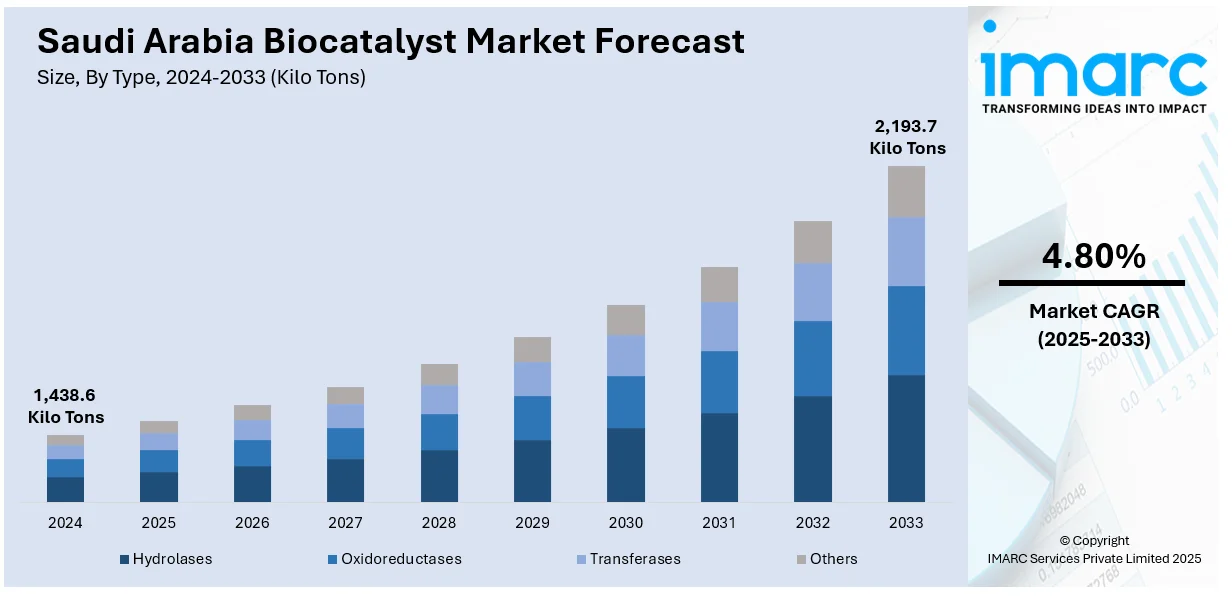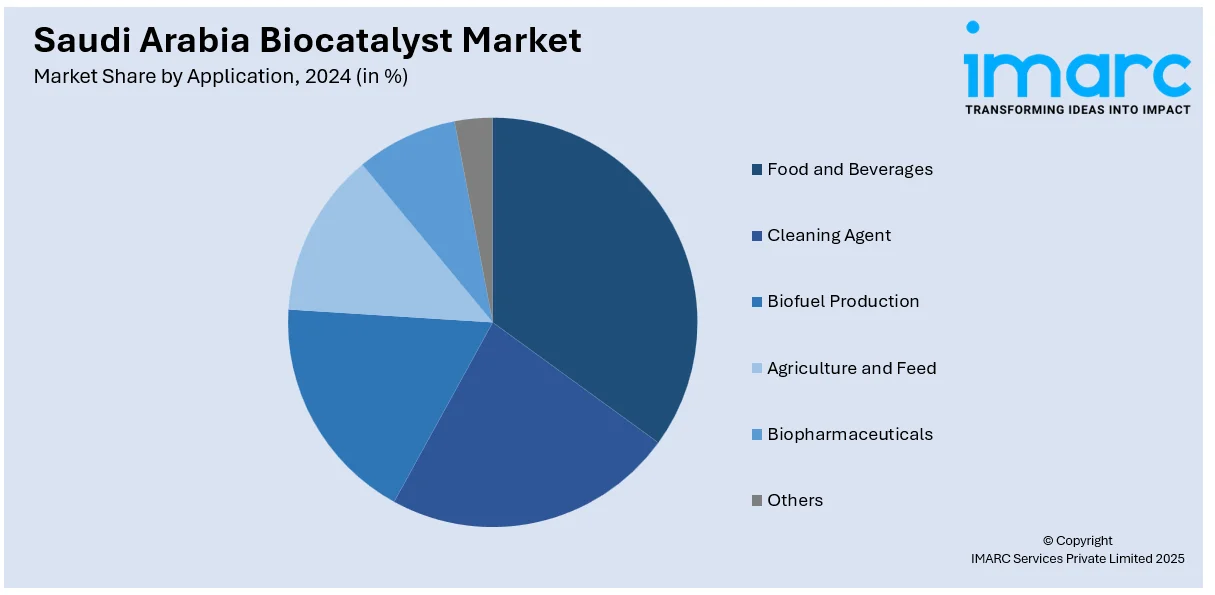
Saudi Arabia Biocatalyst Market Size, Share, Trends and Forecast by Type, Application, Source, and Region, 2025-2033
Saudi Arabia Biocatalyst Market Overview:
The Saudi Arabia biocatalyst market size reached 1,438.6 Kilo Tons in 2024. Looking forward, IMARC Group expects the market to reach 2,193.7 Kilo Tons by 2033, exhibiting a growth rate (CAGR) of 4.80% during 2025-2033. Saudi Arabia’s growing biotechnology sector, supported by rising venture capital and clean energy initiatives, is accelerating the biocatalyst market through targeted investments, policy backing, and increased demand for enzyme-based biofuels aligned with the diversification and sustainability goals under Vision 2030.
|
Report Attribute
|
Key Statistics
|
|---|---|
|
Base Year
|
2024 |
|
Forecast Years
|
2025-2033
|
|
Historical Years
|
2019-2024
|
| Market Size in 2024 | 1,438.6 Kilo Tons |
| Market Forecast in 2033 | 2,193.7 Kilo Tons |
| Market Growth Rate 2025-2033 | 4.80% |
Saudi Arabia Biocatalyst Market Trends:
Increase in Investment and Venture Capital in Biotechnology
Saudi Arabia's biotechnology industry is attracting considerable investment interest, establishing itself as an essential player in the biocatalyst market. The strategic shift from reliance on oil, driven by Vision 2030, is facilitating private equity and international venture capital investments focused on biotechnology advancements. This influx of funding facilitates the advancement and market introduction of cutting-edge biocatalyst technologies by backing research, infrastructure, and scaling initiatives. The momentum is additionally strengthened by the establishment of funds specifically for biotech and policies aimed at drawing in foreign investments. A significant instance of this trend is the 2024 Memorandum of Understanding (MoU) between Saudi Arabia and Vertex Pharmaceuticals, focused on establishing gene therapy manufacturing locally. With intended investments of as much as SAR 1 billion, the agreement bolsters the Kingdom’s goal to become a global biotechnology center by 2040. It highlights research and development (R&D), biomanufacturing skills, and talent growth, each of which aligns with the increasing need for biocatalysts. These strategic partnerships indicate trust in Saudi Arabia’s biotech framework and enhance the local ecosystem by directing resources toward high-potential sectors, such as enzymatic catalysts. The influx of capital along with sustained policy support is boosting local innovation capabilities, leading to greater accessibility of biocatalyst solutions for uses in pharmaceuticals, industrial processing, and environmental management. Therefore, Saudi Arabia is not just enhancing its biotech presence but also establishing a solid groundwork for the expansion of the biocatalyst market.

Demand for Enzyme-Based Biofuels
Rising interest in renewable energy, especially biofuels, is playing a major role in bolstering the growth of the market. As Saudi Arabia shifts towards diversify its energy mix and reduce dependence on crude oil, biocatalysts like enzymes are gaining ground for their role in biofuel production, including bioethanol and biodiesel. These catalysts streamline the conversion of biomass into fuel, offering higher efficiency and lower environmental impact compared to traditional chemical methods. The shift aligns with Saudi Arabia’s broader clean energy vision and mirrors global trends that prioritize sustainability. The local biodiesel sector’s momentum further underscores this shift. In 2024, Saudi Arabia’s biodiesel market was valued at USD 424.1 million, and projections from IMARC Group indicate it will reach USD 694.4 million by 2033, growing at a CAGR of 5.23% from 2025 to 2033. This robust growth reflects expanding domestic interest in renewable fuels and highlights the growing integration of enzymatic solutions to enhance output and sustainability. As production scales up, the demand for efficient biocatalytic processes is creating opportunities for local and international biotech players. With governing body supporting renewable energy projects and technological advancements in enzyme engineering, the biocatalyst sector stands to benefit directly from Saudi Arabia’s transition to a more sustainable energy landscape, positioning it as a vital enabler of the biofuel industry’s future growth.
Saudi Arabia Biocatalyst Market Segmentation:
IMARC Group provides an analysis of the key trends in each segment of the market, along with forecasts at the country and regional levels for 2025-2033. Our report has categorized the market based on type, application, and source.
Type Insights:
- Hydrolases
- Oxidoreductases
- Transferases
- Others
The report has provided a detailed breakup and analysis of the market based on the type. This includes hydrolases, oxidoreductases, transferases, and others.
Application Insights:

- Food and Beverages
- Cleaning Agent
- Biofuel Production
- Agriculture and Feed
- Biopharmaceuticals
- Others
A detailed breakup and analysis of the market based on the application have also been provided in the report. This includes food and beverages, cleaning agent, biofuel production, agriculture and feed, biopharmaceuticals, and others.
Source Insights:
- Microorganisms
- Plants
- Animal
The report has provided a detailed breakup and analysis of the market based on the source. This includes microorganisms, plants, and animal.
Regional Insights:
- Northern and Central Region
- Western Region
- Eastern Region
- Southern Region
The report has also provided a comprehensive analysis of all the major regional markets, which include Northern and Central Region, Western Region, Eastern Region, and Southern Region.
Competitive Landscape:
The market research report has also provided a comprehensive analysis of the competitive landscape. Competitive analysis such as market structure, key player positioning, top winning strategies, competitive dashboard, and company evaluation quadrant has been covered in the report. Also, detailed profiles of all major companies have been provided.
Saudi Arabia Biocatalyst Market News:
- In January 2024, Saudi Arabia launched its National Biotechnology Strategy, aiming to become a leading biotech hub in MENA by 2030 and globally by 2040. The strategy focused on vaccines, bio-manufacturing, genomics, and plant optimization. It supported Vision 2030 by enhancing health, creating 11,000 jobs, and boosting non-oil GDP.
Saudi Arabia Biocatalyst Market Report Coverage:
| Report Features | Details |
|---|---|
| Base Year of the Analysis | 2024 |
| Historical Period | 2019-2024 |
| Forecast Period | 2025-2033 |
| Units | Kilo Tons |
| Scope of the Report |
Exploration of Historical Trends and Market Outlook, Industry Catalysts and Challenges, Segment-Wise Historical and Future Market Assessment:
|
| Types Covered | Hydrolases, Oxidoreductases, Transferases, Others |
| Applications Covered | Food and Beverages, Cleaning Agent, Biofuel Production, Agriculture and Feed, Biopharmaceuticals, Others |
| Sources Covered | Microorganisms, Plants, Animal |
| Regions Covered | Northern and Central Region, Western Region, Eastern Region, Southern Region |
| Customization Scope | 10% Free Customization |
| Post-Sale Analyst Support | 10-12 Weeks |
| Delivery Format | PDF and Excel through Email (We can also provide the editable version of the report in PPT/Word format on special request) |
Key Questions Answered in This Report:
- How has the Saudi Arabia biocatalyst market performed so far and how will it perform in the coming years?
- What is the breakup of the Saudi Arabia biocatalyst market on the basis of type?
- What is the breakup of the Saudi Arabia biocatalyst market on the basis of application?
- What is the breakup of the Saudi Arabia biocatalyst market on the basis of source?
- What is the breakup of the Saudi Arabia biocatalyst market on the basis of region?
- What are the various stages in the value chain of the Saudi Arabia biocatalyst market?
- What are the key driving factors and challenges in the Saudi Arabia biocatalyst market?
- What is the structure of the Saudi Arabia biocatalyst market and who are the key players?
- What is the degree of competition in the Saudi Arabia biocatalyst market?
Key Benefits for Stakeholders:
- IMARC’s industry report offers a comprehensive quantitative analysis of various market segments, historical and current market trends, market forecasts, and dynamics of the Saudi Arabia biocatalyst market from 2019-2033.
- The research report provides the latest information on the market drivers, challenges, and opportunities in the Saudi Arabia biocatalyst market.
- Porter's five forces analysis assist stakeholders in assessing the impact of new entrants, competitive rivalry, supplier power, buyer power, and the threat of substitution. It helps stakeholders to analyze the level of competition within the Saudi Arabia biocatalyst industry and its attractiveness.
- Competitive landscape allows stakeholders to understand their competitive environment and provides an insight into the current positions of key players in the market.
Need more help?
- Speak to our experienced analysts for insights on the current market scenarios.
- Include additional segments and countries to customize the report as per your requirement.
- Gain an unparalleled competitive advantage in your domain by understanding how to utilize the report and positively impacting your operations and revenue.
- For further assistance, please connect with our analysts.
 Request Customization
Request Customization
 Speak to an Analyst
Speak to an Analyst
 Request Brochure
Request Brochure
 Inquire Before Buying
Inquire Before Buying




.webp)




.webp)












